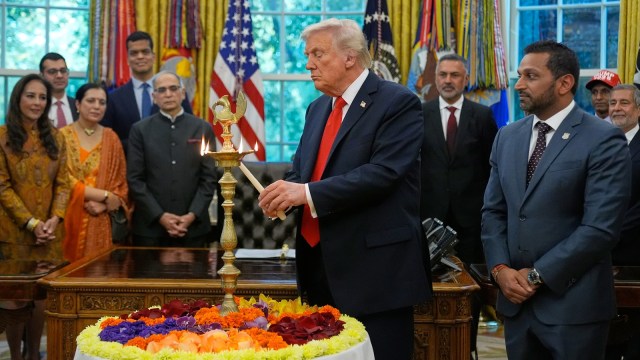
Written by Akshar Patel
This Diwali was different in America. Innocuous diya-lighting, “Happy Diwali” greetings, and the usual roadside fireworks were met with outrage, mockery, and a torrent of abuse online. Even Republican stalwarts were not spared; if anything, they were harangued more for their apparent betrayal.
But why has Diwali, a relatively unimportant festival in the West, triggered such a searing reaction this year?
The answer is multi-layered. First, there is the simple point of increased Indian immigration abroad. Whether through the H-1B visa or crossing a Mexican creek, there is a sentiment that Indian immigration to the US has increased massively. But what do the numbers tell us? The latest estimates pin the Indian-American population at 5.2 million or a minuscule 1.5 per cent of the US’s total population. Even with adding an upper limit of 7,25,000 undocumented Indians, the 1.5 per cent barely shifts a decimal. This does not sound like the invasion purported by certain corners.
So why the ire? When I was younger, being Indian-American was equal to Apu from The Simpsons, the more-than-occasional doctor, or an ordinary mid-level engineer. Quiet professions that attracted little limelight. But now Indian-Americans are in the spotlight. Tech CEOs, acclaimed investors, and even presidential candidates are the new bar for Indian-Americans. This shift is the second layer.
But there are other minority groups who have been successful in America. What makes Indians so special? The answer is deceptively simple: Indians look and act differently. Of all successful American minorities, Indians are the darkest-skinned. They have “strange” customs and worship even “stranger” gods. They do not take Western names and practice the highest rates of racial endogamy, albeit across caste, ethnicity, and religion, at much higher rates than Indians in the Subcontinent. Indian-Americans are simultaneously outwardly foreign but inwardly American through their embrace of American ambition, extroversion, and wealth creation.
There is an element of racial anxiety in witnessing such a tiny foreign population rapidly rise in society and replace old elites. However, all this doesn’t explain one striking part of the hatred — the style.
Many of the slurs and tropes used against Indian-Americans and the festival of Diwali would find a fine home in an Englishman’s tome on the colonial history of India just as much as on a White nationalist forum today. But there were some comments that would appear familiar to Indians at home: Ones that reference cow excrement, casteism, and even Hindu nationalism. This reveals the most insidious part of anti-Indian sentiments in the West: Much of it is being borrowed from the extreme rhetoric of India’s left.
For decades, India’s left has defined Hinduism as an oppressive, regressive force in the Subcontinent — a religion only refined through the civilising encounters it had with Islam and Christianity. No doubt, this is an ironic continuation of colonialist rhetoric regarding India and Hinduism, so in a way, we are seeing things reach full circle with Western commentators and bigots lifting from Indians.
Clichés about cow worship from anonymous racist trolls have given way to incitements of caste conflict from the Donald Trump administration itself in Peter Navarro’s reference to Brahmins swindling other Indians. The fringe has now become the institution. Ironically, the same left-wing mainstream media that America’s far right despises will be copiously referenced for anti-Indian tropes, something in constant supply because of the excess of left-wing Indian authors in papers like The New York Times and The Washington Post.
Yet there is an even more macabre element to this. Violent and dehumanising racism from White nationalists online finds endorsements from India’s left-liberal class. The support from India’s left-liberal elite in framing Indians as backward, irredeemable, and barbarian is shocking to not just Indians but any neutral observer. This type of self-hatred should be a matter of national shame, especially for a country steadily rising but still struggling to break its colonial hangover and shackles of poverty.
Fundamentally, though, the anger over Diwali is that of contradictions. How can a colonised nation so poor and dysfunctional produce a diaspora that is now seemingly “colonising” elite spaces? How can a meagre minority once confined to convenience stores and hospitals now be seen in every frame of fame? How can India’s left, so committed to protecting minorities within India, encourage the most brutish and pedestrian hatred against Indians who are minorities abroad?
These contradictions shine brightest this year. Diwali is no longer about the quiet nostalgia of immigrants but the announcement of a people who are rising. That reversal — from ruled to ruling, from invisible to unmistakable — unsettles both the coloniser’s conscience and the colonised mind still seeking its approval. But light burns brighter in the darkness. And perhaps it is that brightness that unsettles people the most.
The writer is the founder of The Emissary, a platform that explores politics, economics, and history in India and beyond